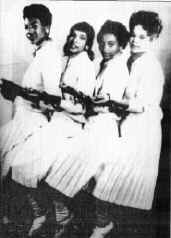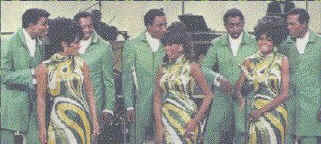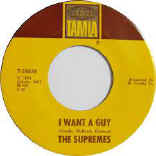Supremes

With twelve #1 pop singles, numerous gold recordings, soldout
concerts, and regular television appearances, the Supremes were
not only the most commercially successful female group of the
Sixties, but among the top five pop/rock/soul acts of the decade.
Members - Primettes
(1959-1960)
Diana Ross
Mary Wilson
Florence Ballard
Betty McGlowan - replaced by Barbara Martin in 1960
Members:
(1961) |
(1962-1967) |
(1967-1970) |
(1970-1971) |
(1972-1973) |
(1974-1976) |
| Florence Ballard |
Florence Ballard |
Cindy Birdsong |
Cindy Birdsong |
Lynda Lawrence |
Cindy Birdsong |
| Barbara Martin |
Diana Ross |
Diana Ross |
Jean Terrell |
Jean Terrell |
Scherrie Payne |
| Diane Ross |
Mary Wilson |
Mary Wilson |
Mary Wilson |
Mary Wilson |
Mary Wilson |

Primettes 1959-1960 (L-R)
Barbara McGlowan, Mary Wilson, Diane Ross, Florence
Ballard
|

Milton Jenkins
|

Primettes/Supremes 1960-1961 (clockwise)
Diane Ross, Florence Ballard., Mary Wilson, Barbara
Martin
|
The Supremes started out as a quartet known as
the Primettes. In 1959 two fifteen year olds, Florence Ballard
and Mary Wilson, met at a talent show. Milton Jenkins, who
managed a local doo wop group the Primes, wanted a sister group
to accompany the Primes for stage performances. Jenkins
asked Ballard to put together such an act. Ballard
remembered Wilson and the two of them brought in sixteen year old
Betty Travis. Prime's member Paul Williams, recommended a fifteen
year old from Detroit's Brewster Housing project Diane Ross.
Jenkins named the group the Primettes after Diane's parents gave
their permission to join. The Primettes then started doing club
dates.
Travis was forced to quit the Primettes because
her parents wanted her to pay more attention to her studies.
Barbara Martin took her place, but had to leave shortly, as did
Ballard, under the same parental conditions. Wilson and Ross
continued to work as duo until the two improved their grades and
were allowed to rejoin.
The groups influences ranged from the McGuire Sisters to Frankie
Lymon and the Teenagers, and unlike most black groups of the time
were not largely influenced by gospel music.
Ballard, Wilson, and Ross could all sing lead, but Ballard's
voice was considered the best and most powerful.
"Florence had a very strong gospel voice,
and she was the original lead singer. When the group came to
Motown, it was Flo's group, she had formed it and named it"
Carolynn Gill of the Velvelettes
In 1960, the they met Ross' neighbor William
"Smokey" Robinson and auditioned for him in the
basement of the home of his girlfriend Claudette Rogers in hopes
of getting to Motown's Berry Gordy. Rogers would later become
Robinson's wife and an original member of the Miracles. The
audition turned into a dead end, but they did audition for Gordy
later, singing the Drifters' "There Goes My Baby."
Gordy told them to come back after they completed high school.
Undaunted the girls began hanging out in Motown's office
reception room. They continued doing local talent shows where
they were spotted by Richard Morris, who brought them to Lupine
Records owner/producer Bob West. They recorded two sides
"Pretty Baby" with Wilson on lead and "Tears of
Sorrow" with Ross on lead for West. Released in 1960, the
record went nowhere and they were soon back hanging around Motown
again, doing handclaps on Marvin Gaye's early records and singing
some backups for blues artist Mabel John.
In January 1961 Gordy signed them, but required
them to change their name. Ballard who had formed the group named
them the Supremes. Wilson and Ross initially disliked the name,
but Gordy approved. By this time Ross was calling herself Diana
Ross.
The Supremes' first single, issued on the Tamla
in April 1961 was "I Want a Guy' and the second an R&B
dance tune "Buttered Popcorn" with Ballard on the lead.
Both went nowhere.
The next three singles barely made the bottom of the Hot 100.
Things were going so badly that in the middle of 1962 Ross took a
job in cafeteria of Hudson's Department store in Detroit and
Martin left to get married.
The best of their early releases "When the Love Light Starts
Shining," in the fall of 1963, reached #23 on the charts. By
the fall of the 1964 the Supremes had released eight singles with
none even making the Top 20.

(R-L) Lamont Dozier, Eiddie Holland, Brian Holland
"Where Did Our Love Go," a
Holland-Dozier-Holland song rejected by the Marvelettes, was
brought to the Supremes. Nonetheless, by August "Where Did
Our Love Go" reached #1 on the Pop and R&B charts. In a
matter of weeks the Supremes went from no billing on the Dick
Clark Caravan of Stars show to top billing.
Ross was now doing all the lead vocals, which did
not always sit well with Ballard.
"It was Berry's choice to put Diana as lead. I think Diana's
voice appealed to Berry because it was young, crisp commercial
sound; maybe Flo's voice was a little to strong for that time. I
don't think Berry chose Diana because he particularly liked her
more than the other girls. They were after all high school kids
to him"
Carolynn Gill of the Velvelettes
"Baby Love" followed in September 1964
and reached #1 Pop, R&B, and in the U.K. The Supremes with
"Baby Love" became the first all girl group to reach #1
in England.
The Supremes became the first American group to
have three number ones from the same album when "Come See
About Me,' released in October, reached #1
With "Stop! In the Name of Love," the
Supremes became the first group to have four number ones in a row
on the Billboard Hot 100. The song also reached
number 2 R&B and number seven in England. The Supremes began
on the historic Motown Revue tour through Europe. It was while on
this tour this tour that the Supremes developed their hand
motions (resembling a traffic cop stopping oncoming car) for
"Stop! In the Name of Love" in the men's room of a
London TV studio with the help of Berry Gordy and the
Temptation's Paul Williams and Melvin Franklin prior to a live
appearance.
"Back in My Arms Again, on June 12, 1965,
became the Supremes fifth #1.
Not only were the Supremes competing head on with
the British invasion, they were becoming superstars in the realm
of pop entertainment. On July 29, 1965 they headlined New York's
famous Copacabana nightclub.
The same month "Nothing But Heartaches"
was released and broke the string of number ones, only reaching
#11. But it was a short lived decline; "I Hear a
Symphony" reached number one on November 20th.
In early 1966 they had hits with "My World
is Empty Without You" (#5) and "Love is Like a Itching
in My Heart" (#9). "You Can't Hurry Love"
reached #1 on September 10, 1966 which began a new string of #1s
that included "You Keep Me Hanging On," "Love is
Here and Now You Are Gone," and "The Happening".
"The Happening" was the last of ten #1s
written by Holland-Dozier-Holland for the Supremes. They left
Motown to form their own labels, Hot Wax and Invictus.
"Over a period of time, favoritism
surfaced, which I believe had something to do with the
romantic link between Berry Gordy and Diana Ross"
Carolyn Gill of the Velvelettes
By now the friction between Ballard and Ross had
taken its toll and Ballard missed twoshows in Montreal and New
Orleans. Part way through the Supremes appearance at the Flamingo
Hotel in :Las Vegas Ballard was fired by Gordy and replaced by
Cindy Birdsong of the Bluebelles.
"Initially there was a phone call -
someone from Motown's office asked me to audition as a
replacement for one of the Supremes. I didn't know who it was. I
actually thought it was a joke. It surprised me, but I got on a
plane and went straight over to Berry Gordy's house. The Supremes
were in a meeting in another room and I was waiting outside. Then
Florence came walking through the living room in tears and that's
what made me know that it was her they wanted me to replace"
.... Cindy Birdsong
Gordy now renamed the group Diana Ross and the
Supremes. Though Diana was gaining stature on her way to a solo
career, the new lineup was not nearly as successful saleswise.
Over the next two years twelve singles were released with only
"Love Child" reaching number one.
The groups first two singles
"Reflections" (#2) and "In and Out of Love"
(#9) were carryovers from the Holland-Dozier-Holland days.

Supremes and Temptations
The group did several good remakes with the
Temptations. "I'm Going to Make You Love Me" was one of
them.
Diana grew more and more estranged from us. We
even stopped recording together. If we were in town just for one
day during a tour, Diana would do all the leads and then the
studio group would do all the back-up vocals when we left. And
that really built up alienation.
"Someday We'll Be Together," issued in
October 1969, became the Supremes last number one record, the
trios last record together, and they performed it in the last of
twenty appearances on the Ed Sullivan Show. Also, it was
the last song they sang together when they appeared at the
Frontier Hotel in Las Vegas on January 14, 1970. Then while on
stage Ross introduced her replacement Jean Terrell.
On March 7, 1970 the Jean Terrell led Supremes
reached the Billboard charts with "Up the Ladder to the
Roof" (#10) and proved the name still had power even without
Ross. In fact, their Right On album with Terrell did
better (#25) than the double live farewell album with Ross (#46).
The new Supremes third single "Stoned
Love" (#7 pop) was a million seller in 1970, and became the
Supremes eighth number one on the R&B charts.
In June 1972, Birdsong left for home and family
and was replaced by Lynda Lawrence, who was followed by a
succession of replacements that included Sherrie Payne, Birdsong
again, and Susaye Greene.

Florence Ballard Chapman's gravestone at Detroit Memorial Park,
Detroit, Michigan
On December 1976 Mary Wilson left and was
replaced by Karen Jackson. The Supremes last pop single was
"You're Driving My Wheel" (#85 1976), and the group was
soon disbanded. Florence Ballard, after leaving the Supremes in
1967, did two singles for ABC Records and then spent several
years fighting Motown in a lawsuit over her firing. She lost the
suit and spent sometime on welfare attempting to support her
three children. Overweight and despondent, Ballard died of a
heart attack at Monte Carmel Mercy Hospital in Detroit at the age
of thirty two.
The driven and aggressive Ross realized her every
dream as a superstar performer and actress of the 70s and
80s. She had forty-one Hot 100 hits and her movie career
included roles in Lady Sings the Blues and The Wiz.
Mary Wilson went on to form her own group Mary
Wilson and the Supremes, with Karen Jackson and Karen Ragland.
In May 1983, she, Ross, and Birdsong reunited for
Motown's 25th anniversary TV show.
In 1984, Wilson wrote her story Dream Girl: My
life as a Supreme.
On February 8, 2021, Mary Wilson died in her
sleep from hypertensiveatherosclerotic cardiovascular disease at
her home in Henderson, Nevada, a suburb of Las Vegas, at the age
of 76.

Former Ladies of the Supremes
The number one female group had 18 Hot 100 hits
as the Supremes, nine as Diana Ross and the Supremes, three as
Diana Ross and the Supremes and Temptations, twelve as the
Supremes after Ross left, and two as the Supremes and the Four
Tops. Obviously, the whole was always greater than its parts to
its fans, and the Supremes sound as good at the end as they did
when the hits first started.
Mary Wilson died in her sleep at her home in
Henderso, Nevada February 2021 at the age o76. The cause
of was Atherosclerosis.
Betty McGlown died of diabetes Junuary 12, 2008 at Beaumont
Hospital in Royal Oak, Michigan at the age of 66.
Betty Martin died March 4, 2020 at the age of 76.
Florence Ballard died February 22, 1976 caused by coronary
thombosis, a clot in a coronary artery, at the age of 32.
The Supremes were inducted into the Rock and Roll
Hall of Fame in 1988.
The Supremes were into the Vocal Group
Hall of Fame in 1998.










